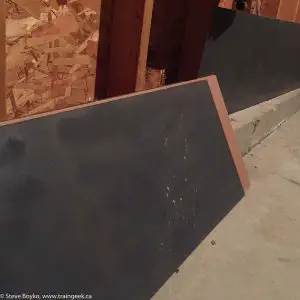Analysis paralysis. This is me right now.
I have a number of model train projects on the go, and I’m not executing on any of them.
Lance Mindheim just wrote a post “Fear of the Inconsequential” where he wrote about the “fear of getting it wrong”. That’s me, all right.
What do I have going on?

Neglected fascia Fascia – I started installing fascia on the layout, but I quickly realized I don’t know how to get around the corners. I’ve reached out for help, got some, but I lack confidence. Some of it is too long and needs to be trimmed, and I don’t have a table saw. I feel like it’s not going to look very professional, so right now the majority of the fascia sits in my garage, painted and slowly getting dirty and unusable.
- Ballast – I’ve ballasted all of the visible CN track that I am going to do. I’ve done patches of the CP track but I haven’t finished it. Why not? I really don’t know.
- Scenery – I’ve done some bits of scenery here and there, but the main part of the layout – Georgetown – is undecorated. I have an idea in my head of what it should look like, but I don’t know where to start so I don’t.
- Kits – I have several model kits that I haven’t started. Some are Intermountain grain hoppers and for those I am just intimidated by the number of parts. I have a couple of Athearn “blue box” kits that I know I can do, but I haven’t done them. Also I have a grain elevator mostly complete, but I can’t move from 85% complete to 100% complete because.. I don’t know why not. I have some great decals from Precision Design on it but I need a few more.
I know I should “just do it” as Nike said. Something is better than nothing. I can always go back and make it better if I don’t like the result.
I know this.
But I have to get over this internal fear of screwing up before I can move forward.
Here’s hoping that happens soon.
What do you do to push past these internal roadblocks?